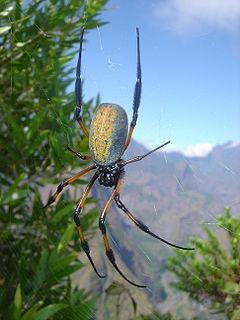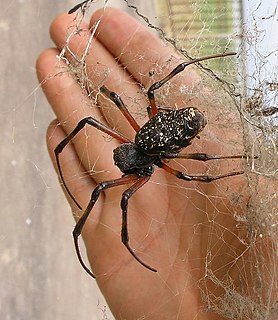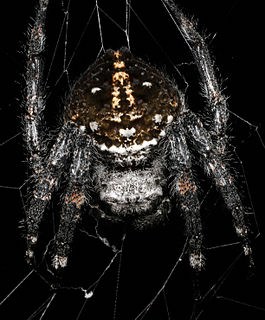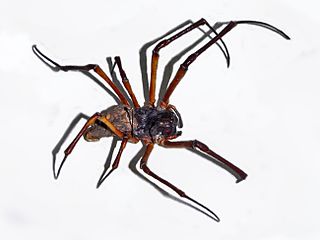
Orb-weaver spiders are members of the spider family Araneidae. They are the most common group of builders of spiral wheel-shaped webs often found in gardens, fields and forest. "Orb" can in English mean "circular", hence the English name of the group. Araneids have eight similar eyes, hairy or spiny legs, and no stridulating organs.

Nephila is a genus of araneomorph spiders noted for the impressive webs they weave. Nephila consists of numerous species found in warmer regions around the world. They are commonly called golden silk orb-weavers, golden orb-weavers, giant wood spiders, or banana spiders.

Trichonephila inaurata,, commonly known as the red-legged golden orb-weaver spider or red-legged nephila, is a species of orb-weaver spider of the genus Trichonephila. It is native to southern and East Africa, as well as several islands of the western Indian Ocean.

Trichonephila clavata, also known as the Jorō spider, is a member of the golden orb-web spider genus. The spider can be found throughout Japan, in Korea, Taiwan, China, and more recently, northeast Georgia in North America. Due to the large size as well as the bright, unique colors of the female Trichonephila, the spider is well-favored in Japan.
Mesozygiella is an extinct genus of orb-weaving spider, with one known species, Mesozygiella dunlopi, dating from the Early Cretaceous, making it the earliest orb-weaver yet discovered. Two male specimens of the species were found embedded in amber in Álava, northern Spain. The fossils provide direct evidence that the three major orb weaving families, namely Araneidae, Tetragnathidae and Uloboridae, had evolved by this time, about 140 million years ago. They probably originated during the Jurassic. All three families very likely have a common origin.

Nephilinae is a spider subfamily of the family Araneidae with seven genera. The various genera in Nephilinae were formerly grouped in the family Nephilidae, and before that in the Tetragnathidae and in the Araneidae. All nephiline genera partially renew their webs. Spiders in the subfamily Nephilinae are commonly referred to as golden orb-weavers.

Zygiella x-notata, sometimes known as the missing sector orb weaver or the silver-sided sector spider, is a spider species in the family Araneidae. They are solitary spiders, residing in daily-spun orb webs. Z. x-notata is a member of the genus Zygiella, the orb-weaving spiders. The adult female is easily recognized by the characteristic leaf-like mark on her posterior opisthosoma, caudal to the yellow-brown cephalothorax.

Zygiella is a genus of orb-weaver spiders first described by F. O. Pickard-Cambridge in 1902. In 2015, Parazygiella was determined to be a taxonomic synonym of Zygiella, and its species were moved to Zygiella.

Trichonephila edulis is a species of large spider of the family Araneidae, formerly placed in the genus Nephila. It is referred to the common name Australian golden orb weaver. It is found in Australia, in both tropical and temperate regions, and in parts of New Guinea and New Caledonia.
Nephilengys is a genus of tropical spiders of the family Araneidae, consisting of two currently described species. The genus Nephilingis has been split off from this genus. Both genera have been called hermit spiders from the habit staying in their retreats during the day; the name eunuch spiders has been used for Nephilengys alone. Males may sever parts of their palpal bulbs after copulation.

Nephilingis cruentata is an araneid spider with a strikingly red sternum.

Darwin's bark spider is an orb-weaver spider that produces the largest known orb webs, ranging from 900 to 28,000 square centimetres, with bridge lines spanning up to 25 metres (82 ft). The spider was discovered in Madagascar in the Andasibe-Mantadia National Park in 2009. Its silk is the toughest biological material ever studied, over ten times tougher than a similarly-sized piece of Kevlar. The species was named in honour of the naturalist Charles Darwin, with the description being prepared precisely 150 years after the publication of The Origin of Species, on 24 November 2009.

Herennia multipuncta, commonly known as the ornamental tree trunk spider, is a species of spider in the family Araneidae native to Asia. It exhibits sexual dimorphism, the female being much larger than the male. It weaves a small web on the trunk of a tree or the wall of a building and is well camouflaged by its dappled colouration.

Caerostris, sometimes called bark spiders, is a genus of orb-weaver spiders first described by Tamerlan Thorell in 1868. Most species are found in south eastern Africa and neighboring Madagascar.

Nephila sumptuosa, the red-legged golden orb-web spider, is a species of golden orb-web spider.

Nephilingis is a genus of spiders in the family Araneidae. It was split off from the genus Nephilengys in 2006. Both genera have been called hermit spiders from the habit of staying in their retreats during the day; alternatively the name "hermit spider" may be reserved for Nephilingis, with Nephilengys species called "eunuch spiders".
Guizygiella is a genus of Asian long-jawed orb-weavers that was first described by M. S. Zhu, J. P. Kim & D. X. Song in 1997.

Yaginumia is a genus of Asian orb-weaver spiders described by Allan Frost Archer to hold the single species, Yaginumia sia. This species was moved from Aranea to Zygiella in 1942, before moving to this genus in 1960. It has only been found in China, Korea, Taiwan, and Japan.
Zygiella nearctica is a species of orb weaver in the spider family Araneidae. It is found in Canada and the United States.
Zygiella carpenteri is a species of orb weaver in the spider family Araneidae.













